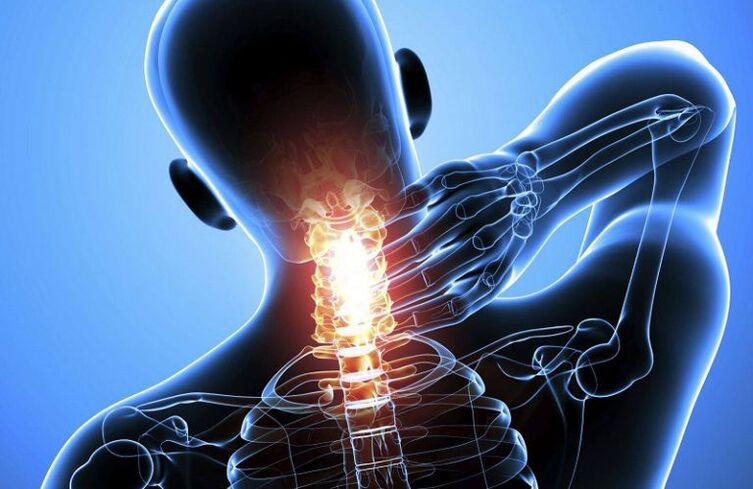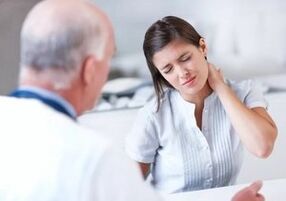Neck pain has been encountered several times in people’s lives. If the back of the neck hurts, the cause is in most cases the cervical spine. Let's take a closer look at each disease.
Myositis
In case of hypothermia and colds, myositis of the neck develops - acute inflammation of the muscles. A person begins to feel severe pain in the neck and shoulders, with a slight rise in temperature. When the painful area is felt, the skin above the muscle is edematous, swollen, and hot to the touch. When you try to turn your head to the affected side, there is sharp pain and tension in the neck muscle.

Myositis may be due to respiratory or viral disease. Then there is pain in the throat and neck, the lymph nodes swell.
Treatment
Non-steroidal anti-inflammatory drugs help to stop inflammation quickly and effectively. Various ointments and gels can be used topically. An important fact about the final passage should be added here - it should be applied in a thin layer and should not be washed off with water under any circumstances.
You can use a semi-alcoholic and warming compress - with vodka, dilute alcohol or dimexide. Folk remedies also help well: boiled potatoes, rubbing with honey, using crushed cabbage leaves.
In addition to treating myositis, they also treat colds - antiviral or antibacterial drugs, vitamins, sprays in the nose and throat. The spray is a great help for quick relief of sore throats - a powerful antibacterial and antifungal drug, the effect of which can be felt 20-30 minutes after starting treatment.
Cervical osteochondrosis
Everyone has heard of the disease, but the causes are still mysterious.
Predisposing factors are injuries, prolonged compulsion, microtrauma of muscles and tendons during heavy physical work, dystrophic processes in the spine, old age, menopause.

Protrusion, instability, hernia in the cervical spine, compression of nerve roots, blood flow to the vertebral artery cause disturbances, leading to cerebral ischemia.
All symptoms of cervical osteochondrosis are divided into:
- reflex;
- compression radical and vascular;
- spine.
More:
- Reflex symptoms are manifested by prolonged irritation of the tissue receptors in the pathological spine. Nerve impulses from the affected vertebrae enter the spinal cord, causing changes in the surrounding muscles and tissues. The muscles of the healthy side take over all the functions, forming an abnormal stereotype about movement. And the muscles of the affected side fix the displaced vertebra in a certain position, preventing it from further curvature. But they also do not provide an opportunity to take a physiological position. If at this moment a person does not go to the doctor and chiropractor, muscle atrophy occurs, degenerative changes in the tissues of the vertebrae, osteochondrosis of the neck develops. In the future, the progression of the disease will cause inflammation and fibrosis of the muscles of the shoulder girdle, inflammation of the periarticular sac. Reflex symptoms:
- pain along thorny processes - touching the neck causes discomfort, pain, shot in the vertebrae;
- tension and pain in the back neck muscles aggravated by turning the head or probing;
- cervicalgia - aching or sharp pain in the neck, which can sometimes subside, giving the person rest. But with loads, staying in a long sitting position (such as while flying, long trips on a bus or car), the pain won’t wait long. In cervicalgia, the person hears cracks in the neck on a regular basis, feeling uncomfortable and numb on the skin;
- cervicocranialgia - heaviness and aching pain in the neck that spreads to the head. Most often the back of the head suffers - heavy, "pulsating", a feeling of numbness, a person wanting to support his head with his hands or leaning on a hard surface. Sometimes there are "heat waves" - the back of the head and neck appear to be burning or freezing. Sleep also suffers - intermittent, shallow, the patient wakes up sluggish in the morning, apathetic, tired. The pain may extend to the whole head - light phobia occurs, astringent pains in the temple, neck, eyes, high blood pressure, nausea and vomiting often occur;
- cervicobrachialgia - pain in the neck region that extends to the shoulder and arm. Pain and cramps in the muscles of the shoulder, stiffness, pain in the shoulder joint, cracking, difficulty when trying to lift or remove the arm.
- Compression of the roots and blood vessels of the spinal cord is manifested in vertebral artery syndrome. It is a large complex of various manifestations of vertebral compression. There are three groups of symptoms that directly indicate the disease:

- throbbing and painful headache of a persistent or rapid nature, burning, unbearable. It grows in a prolonged awkward position, extending from the occiput to the forehead;
- cochleovestibular lesions - dizziness, insecurity while walking, various noises in the ear (clicking, ringing, buzzing). The patient's dizziness is constant or paroxysmal, which impairs a person's quality of life;
- visual pathology - darkening and "flies" in front of the eyes, discomfort and "sand" feeling, burning, decreased vision.
There are several manifestations of vertebral artery syndrome:
Barre-Lieu syndrome - pain in the back of the neck and occipital region that goes to the front of the head - "removal of the helmet". It intensifies after night and sleep, especially if the person has slept on an uncomfortable pillow. When the head is turned, dizziness and tinnitus occur, and the eyes darken.
Basilar migraine - darkness appears in the eyes before a migraine attack, flashing black dots, photophobia. The seizure begins with severe dizziness, tinnitus, and impaired articulation of the tongue (the person has difficulty pronouncing the words). The intense pain in the back of the neck, in the back of the head, makes the person immobile to reduce the attack. At the height of the headache, vomiting appears, in severe cases - fainting.
Cochleovestibular symptom - aching pain in the back of the neck, crackling when the head is tilted and turned, dizziness, hearing loss and difficulty speaking. Patients are often unable to distinguish between whispering speech.
Ophthalmic syndrome - background of osteochondrosis of the neck with impaired vision. In humans, reading quickly causes fatigue, loss of vision, reddening of the conjunctiva, and tearing.
Spondylarthrosis
The disease is characterized by "wear and tear" of the cartilage, with bone outgrowths along the edge of the joint surface. The disease occurs at any age, but most commonly debuts in the elderly. Trauma, inflammation, and congenital joint lesions can cause spondylarthrosis.
Symptoms
The patient is disturbed by aching pain in the cervical spine, exacerbated by turning and tilting the head. Often a person cannot turn his head completely to the side, an attempt to increase the range of motion causes back pain. In the supine position, the pain recedes. In addition to the neck, the spine, knee and hip joints are involved in the process.
As the disease progresses, the intervertebral canal narrows in the cervical and lumbar regions. Spondylogenic myelopathy - a chronic disease of the spine with a weakening of muscle tone and dysfunction of internal organs. Myelopathy increases the pain in a person, reduces the rate of blood flow in the vessels of the neck and head.
Spondyloarthritis
Prolonged pain in the back of the neck, inability to bring the head completely to the chest - symptoms may include rheumatoid arthritis of the spine. The disease develops in the background of polyarthritis - multiple changes in the joints.
Symptoms
The pain occurs in the back of the neck, spreads to the back of the head, intensifies when the head is tilted back and forth, turning right and left. One cannot fully move the head, the muscles of the neck are tense and painful. In severe cases, a life-threatening complication develops - bulbar syndrome. Its manifestations are varied and depend on the degree of stinging of the medulla oblongata during atlas subluxation. The patient's speech is disturbed - blurred, slow, and one quickly gets tired of speaking. Swallowing is also disturbed, especially in liquid foods. The person drowns, the fluid flowing out through the nose or the corner of the mouth. Cardiac disorders - arrhythmias, tachycardia.

In children, cervical spondyloarthritis develops as a complication of acute sinusitis, an inflammation of the sinuses. The disease was named Grisel torticollis after a French doctor. The disease develops due to a defect in the articulation of the atlas and the teeth of the axial vertebrae.
The symptom of the disease is specific and allows a quick diagnosis to be made: the child’s head leans towards the source of the inflammation and turns slightly towards the healthy side.
The treatment for cervical osteochondrosis and spondyloarthritis is the same. The patient needs to be consulted and treated by a chiropractor. The specialist will replace the vertebrae quickly and painlessly, so there is no need for expensive treatment at the clinic. If necessary, the clinic's neurologist prescribes a course of medication every six months or annually: these are injections and tablets given intramuscularly or intravenously.
Well it helps in the treatment of osteochondrosis of the neck by massaging the collar zone, acupuncture. You can use self-massage - rub the neck muscles from the back of the head down to the shoulder with soft circular motions. It is not possible to force the muscles of the neck by force - it can provoke an increase in arterial and intracranial pressure.
Patients often use the applicator - the point effect of the needles reduces muscle tension, stimulates blood circulation. Applicators should only be used after consulting a doctor and making an accurate diagnosis - needles are contraindicated in the oncological process as they stimulate tumor growth.
Nootropic therapy is mandatory for vertebral artery syndrome and cerebral ischemia: intravenous injections that stimulate vascular circulation, increase oxygen supply to the brain, and reduce dizziness and tinnitus.
Tuberculosis of the spine
With the spread of tuberculosis in the bones and joints, it most often affects the spine. The danger of the disease lies in the long silence. Tuberculosis does not occur in any way for 2-4 years. As the disease progresses and the vertebral bodies die, heaviness occurs in the neck and shoulders, with obscure pain in the spine without clear localization.
Man is unable to keep his head alone for long periods of time, constantly trying to support him with his hands. Due to severe neck pain, the patient avoids turning and tilting the head. As the vertebra is destroyed, the process spreads to the surrounding tissues, forming an abscess - an abscess in the capsule. The back of the neck shows a thickly swollen, slowly increasing swelling. The abscess can spread to the pharynx, causing coughing, difficulty swallowing and a sore throat.
The treatment of the tuberculosis process is performed in a special tuberculosis outpatient clinic. The treatment is difficult and lengthy, with many side effects. Powerful bactericidal preparations of synthetic origin are used. Doses of the course are prescribed with 2-3 medications. During the treatment, monthly blood and urine tests and mycobacterium tuberculosis tests are performed. Once every two months, the patient undergoes an x-ray.
Cervical spine cancer
The tumor can occur at any age. The neoplasm can grow from cartilage, bone, and nerve tissue. The tumor may be an independent disease or a metastatic focus on another organ. Most commonly, metastases in the cervical region cause breast, prostate, lung, and stomach cancers.
The symptoms increase with the spread of the tumor: the person has constant neck pain and difficulty turning and turning the head. There is weakness, sweating, fatigue. The growth of the tumor and the compression of the roots and blood vessels lead to tremors and weakness in the arms and shoulder girdle, constant headaches and dizziness.
Treatment
Apply:
- surgery - complete radical excision of the tumor in healthy tissues;
- chemotherapy - cytotoxic drugs that slow down the division of tumor cells and prevent them from growing further;
- radiation therapy - the effect on tumor cells with ionizing radiation;
- symptomatic treatment - painkillers, most commonly narcotic painkillers, are used in the final stages of cancer.
Spinal cancer is an extremely dangerous disease, manifestations of which are often attributed to osteochondrosis, and treatment is late. Therefore, if pain occurs in the cervical spine, X-ray or magnetic resonance imaging should be performed. This allows a quick diagnosis to be made and appropriate treatment to be started.
In an outpatient clinic, MRI is extremely rarely prescribed for financial reasons - but this test is done in many private centers for a fee. It is better to pay thousands of rubles and protect yourself than to treat the disease for a long time without knowing what the source of the trouble is.























